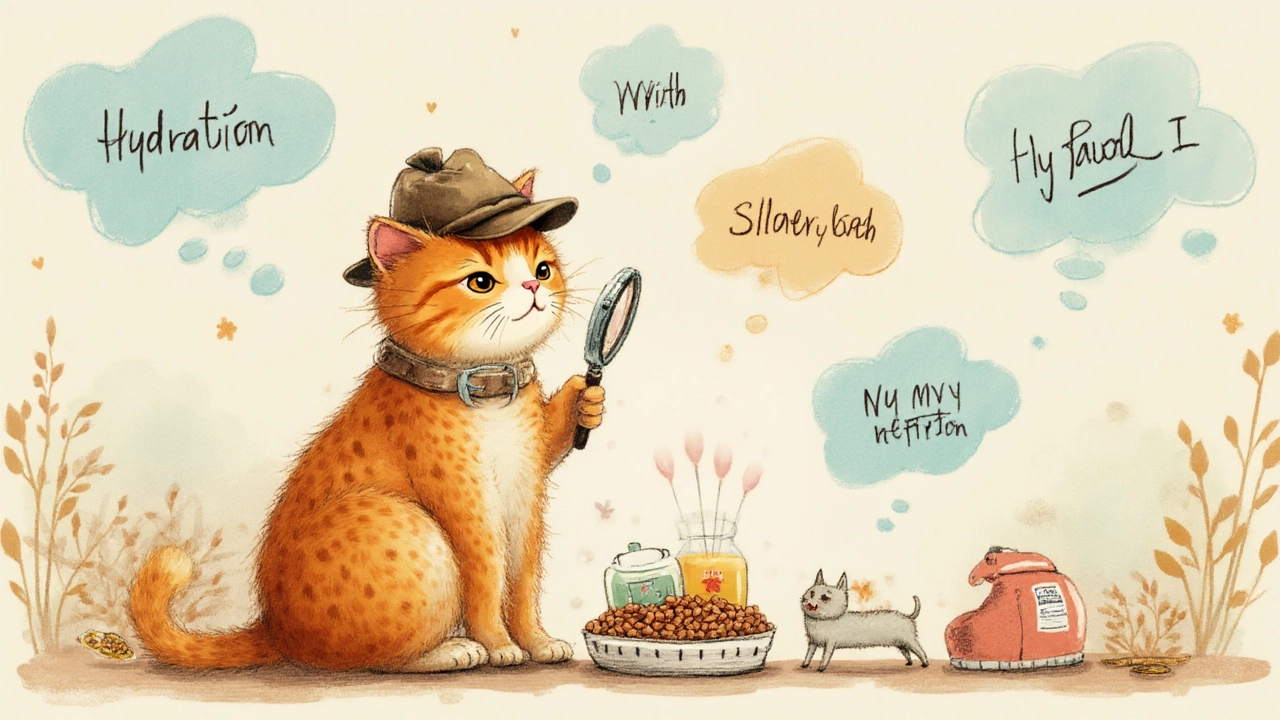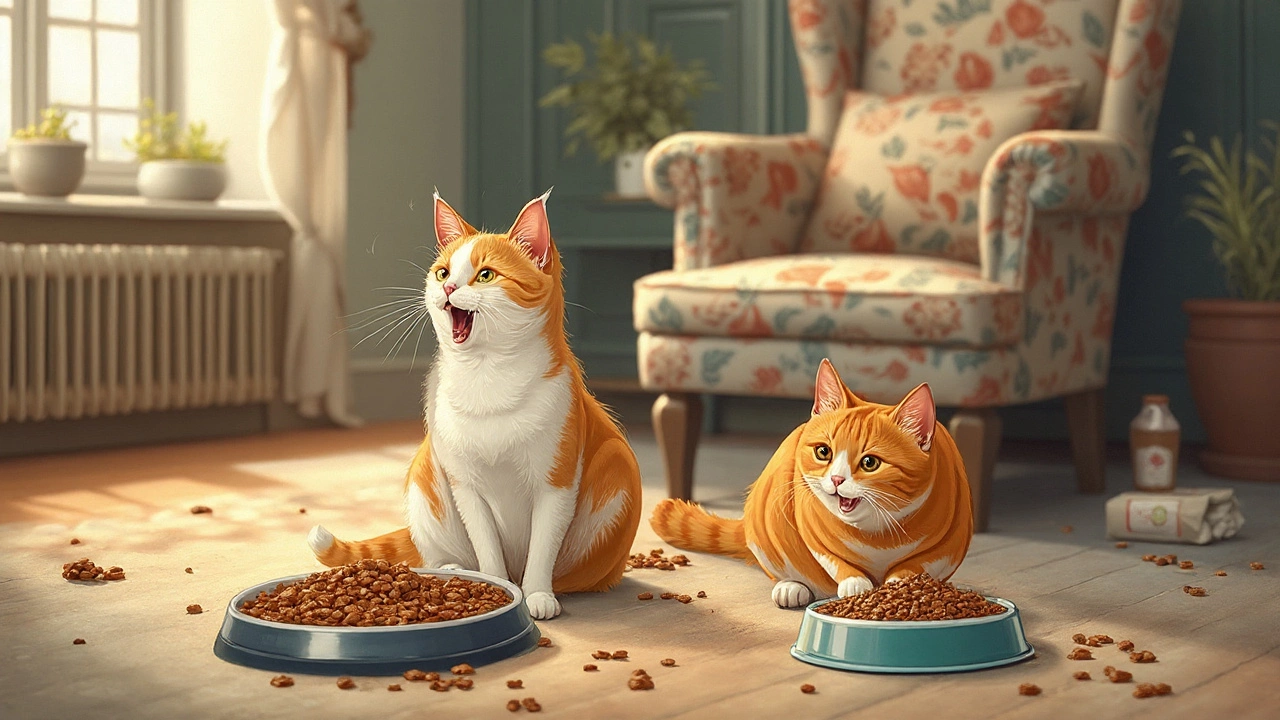Picture this: you pour dry kibble in your cat’s bowl, and she crunches away, totally content. But next door, your friend pops open a can of wet food and her cat comes running, eyes wide. Both cats look happy, but does it really matter if you choose wet or dry? It’s not just about what your cat likes. It can affect her kidneys, her weight, her teeth, and her mood—and those details aren’t always obvious on the packaging. This debate is bigger than the classic tuna vs. chicken standoff. Cats are quirky little carnivores, and their bodies work in strange ways compared to ours. Let’s go deep—like “finding a toy in the couch cushions” deep—on the pros and cons of wet cat food and dry cat food so you can finally ditch the guessing game.
What’s Inside: Comparing Nutrition, Hydration, and Ingredients
Everyone loves the idea of their beloved furball getting gourmet meals. But let’s cut through the marketing and look at the real ingredients. Wet food, that mushy stuff in cans or pouches, is mostly water—sometimes as much as 80%. It’s rich, it smells like a dream (to a cat), and it’s usually made up of actual meat, organs, broth, and a few added vitamins and minerals. That extra water? It’s not a filler. It mimics the moisture cats would get eating prey in the wild—think of a mouse, which is about 70% water. Hydration matters big-time: cats have a low thirst drive, meaning they won’t just drink water on their own like a dog might. Wet food can be a quiet lifesaver for those sneaky urinary tract problems or kidney issues, especially in older cats or breeds prone to these conditions.
Dry food—yep, that crunchy kibble—flips the balance: only about 10% moisture, and the rest is carbs, proteins, and fats. Dry food brands can pack in proteins and calories, but to keep those crisp little biscuits from turning into rocks, they have to use more starches like corn, rice, or potato. Here’s the real deal: cats don’t actually need many carbs. In fact, too many can contribute to obesity, diabetes, or digestive troubles over time. But it’s not all doom and gloom—high-quality dry cat food has come a long way in the last decade. Many brands use novel proteins, better fats, and fewer fillers than older formulas. And yes, it’ll stay fresh for weeks in a bag—handy for busy cat parents or free-feeders.
Think labels are confusing? It’s not your imagination. The word “chicken” might mean actual chunks of chicken breast, or it could just mean ‘chicken flavor’ added to mystery meat. If you ever need inspiration for what to avoid, the Association of American Feed Control Officials (AAFCO) sets standards (in North America at least) for what’s actually in pet food—but not every product meets those. Look for foods with a named protein right at the top of the ingredient list, like “turkey” or “beef”—avoid anything that says “by-products,” “meal,” or scary-sounding chemicals you can’t pronounce. Some brands shout about being “grain free,” but research hasn’t found grains to be harmful for most healthy cats. It’s more about the total percentage of protein, fat, and quality ingredients—not just buzzwords.
Ever wondered about the age or breed of your cat? Climbers and playful kittens turn their calories into zoomies, but a senior cat or a couch loaf may need fewer calories but more hydration or fiber. Wet food is easier for toothless elders or cats with dental issues, while a high-protein dry food suits an energizer kitten. It’s all about matching the food to your cat’s lifestyle and life stage, not just what’s cheapest or on sale. Fancy a feline with hairball problems? Some foods, especially dry blends, add fiber to help things, uh, move along—check the back of the bag for beet pulp or psyllium, if your vacuum has been working overtime on furballs.

Real-World Issues: Practical Pros and Cons of Wet and Dry Food
If only the answer were as simple as “just pick the one your cat likes best,” right? The reality involves time, money, convenience, and a little bit of cat psychology—plus, the mess factor. Wet food is unbeatable for cats who won’t touch their water dish. Studies show that cats on a wet food-only diet are less likely to suffer from chronic dehydration, which is linked to kidney disease and urinary blockages. For males, especially neutered boys, this can be a genuine game-changer: bladder obstructions in cats can get serious within hours. By giving wet food, you’re sneakily helping your cat flush out his bladder every day—without a single extra drop from his water bowl.
BUT (and it’s a big one), wet food can get pricey—especially with large-breed or multiple cats. You have to open a new can every meal to keep things fresh, it smells stronger, and uneaten bits attract ants in summer (or worse, flies). And while wet food boosts hydration, it’s messier: you’ve got to wash bowls after every meal, or risk that weird jelly stuff crusting up like wallpaper glue. Forget to put it away, and you’ll be tossing it after two hours, which can feel wasteful and expensive.
Dry food? It’s basically convenience in a bag. It doesn’t spoil for ages left out, which makes it perfect for people who work long or irregular shifts, and cats who ‘graze’ instead of eating at set times. Scoop some in the bowl, and you’re good. Dry foo—contrary to the myth—doesn’t fully “clean” your cat’s teeth (those tiny kibbles break too quickly to have the effect of a toothbrush), but some dental formulas with special shapes or added enzymes can help decrease tartar and keep gums happier, at least in theory. For cats who love to crunch, it keeps mealtime stimulating.
Leaving out kibble can turn into a free-for-all. Some bored indoor cats snack far more than they should, and it’s easier to lose track of total calories. Obesity is a real concern; as cat owners, we tend to underestimate portion sizes, especially with free-feeding. Extra pounds increase risks for diabetes, arthritis, and even some cancers. If you go the dry route, consider a puzzle feeder so your cat works for her dinner. Bonus: it helps with boredom and mental stimulation.
You know your cat’s routine best—do you work from home, or do you sometimes get caught out late? Would you rather have extra wet food pouches in the fridge, or a bag of dry that covers the whole week? If you travel a lot or leave home for long days, a timed automatic dry feeder is a lifesaver. Got a picky eater? Some cats go wild for pate, others will only eat dry if it’s sprinkled on top of wet food. Mixing both—sometimes called “combo feeding”—can combine the hydration boost of wet and the convenience of dry. Just remember: more variety also means your cat will expect her personal chef’s best effort every meal! And if you’ve ever had a cat go on a hunger strike for a certain flavor, you know who’s really in charge.
Special tip: always consult your vet if your cat suddenly won’t eat, or starts drinking and urinating more often. Sometimes the problem is medical, not preference. And if you’re introducing a new food? Go slow—like one new food over a week. Cats can be really stubborn about texture or flavor switches, and sudden changes can upset their sensitive stomachs.

Vet Advice, Tips, and Custom Solutions
Veterinarians see the fallout from poor diets every day—think overweight cats with diabetes, older cats in kidney failure, and kittens with stunted growth from inadequate protein. Year after year, big clinics like Banfield Pet Hospital report kidney trouble as one of the top reasons aging cats come in. A big culprit? Chronic dehydration from relying too much on dry kibble. Yet, not every cat thrives on wet food; dental disease, bad breath, or fussy eaters often have different needs. It’s never one-size-fits-all.
If your cat’s healthy and active, and you trust the brand, a high-protein dry food can be completely fine—just keep a close eye on weight and water intake. Many people switch to wet food as cats age, because older cats can have reduced thirst and weaker kidneys. Or, if you notice constipation, hairballs, or difficulty chewing, wet food’s texture can be a major help. Vets sometimes recommend all-wet food diets for cats with urinary crystals, as water dilutes minerals that cause painful stones. For cats with food allergies, the texture and formula of prescription wet foods make it much easier to avoid trigger ingredients.
Still stuck choosing? Here are some practical tips backed by what actual vets and cat nutritionists suggest:
- Watch for any signs of dehydration: gums should be moist, skin should snap back quickly if gently pinched behind the neck, and urine shouldn’t always be super-concentrated.
- If you stay with dry, boost your cat’s water intake. Try a cat water fountain, add ice cubes, or serve water in multiple bowls around the house—some cats love drinking from weird places.
- Mix it up—``combo feeding’’ lets you give wet for hydration and dry for calorie control, adjusting proportions over time as your cat’s needs change.
- Portion control matters, no matter what food. Measure meals instead of guessing “what looks right.” The feeding guides are a good start, but always watch your own cat’s body condition and activity level.
- Don’t panic about fancy new protein sources—duck, venison, rabbit—unless your vet recommends them. Most cats do fine on chicken, turkey, or beef blends that are labeled as “complete and balanced” by AAFCO or similar standards.
- Don’t let anecdotal stories or internet debates sway you. The right answer is what fits your cat’s medical history, behavior, and your lifestyle as their caretaker.
Your relationship with your cat matters way more than trends or advertising claims. The best food is the one your cat eats happily and stays healthy on. Some cats go wild for stinky fish pâté, others prefer the crunch. Notice their preferences and monitor their weight, teeth, poop (yes, you need to check), mood, and coat condition. If something changes—especially sudden weight loss or change in eating habits—call your vet.
Bottom line, the wet vs. dry cat food question isn’t a battle with a single winner for everyone. It’s about balance, quality, hydration, and what your cat’s body needs most at her stage of life. Try to get the facts straight, look past the flashy packaging, and trust your instinct—you know when your cat’s happy, and now you have the info to keep her purring for years.
